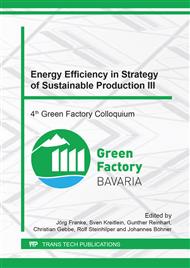[1]
T. v. Kármán, Über laminare und turbulente Reibung, in: Zeitschrift für angewandte Mathematik und Mechanik, volume 1, (1921), pp.234-252.
DOI: 10.1002/zamm.19210010401
Google Scholar
[2]
J. M. Owen, R. H. Rogers, Flow and Heat Transfer in Rotating-Disc Systems, Volume I: RotorStator Systems, Research Studies Press, (1989).
Google Scholar
[3]
J. M. Owen, R. H. Rogers, Flow and Heat Transfer in Rotating-Disc Systems, Volume II: Rotating Cavities, Research Studies Press, (1995).
Google Scholar
[4]
T. Indinger, I. V. Shevchuk, Transient Laminar Conjugate Heat Transfer of a Rotating Disk: Theory and Numerical Simulations, in: International Journal of Heat and Mass Transfer, volume 47, no. 14, (2004), pp.3577-3581.
DOI: 10.1016/j.ijheatmasstransfer.2004.01.023
Google Scholar
[5]
I. V. Shevchuk, M. H. Buschmann, Rotating Disk Heat Transfer in a Fluid Swirling as a Forced Vortex, in: Heat and Mass Transfer, volume 41, no. 12, (2005), pp.1112-1121.
DOI: 10.1007/s00231-005-0635-8
Google Scholar
[6]
I. V. Shevchuk, Unsteady Conjugate Laminar Heat Transfer of a Rotating Non-Uniformly Heated Disk: Application to the Transient Experimental Technique, in: International Journal of Heat and Mass Transfer, volume 49, no. 19, (2006), pp.3530-3537.
DOI: 10.1016/j.ijheatmasstransfer.2006.03.001
Google Scholar
[7]
I. V. Shevchuk, Convective Heat and Mass Transfer in Rotating Disk Systems, Springer Berlin Heidelberg, (2009).
Google Scholar
[8]
S. aus der Wiesche, Heat Transfer and Thermal Behaviour of a Rotating Disk passed by a planar Air Stream, in: Forschung im Ingenieurwesen, volume 67, no. 4, (2002), pp.161-174.
DOI: 10.1007/s10010-002-0091-2
Google Scholar
[9]
S. aus der Wiesche, LES Study of Heat Transfer Augmentation and Wake Instabilities of a Rotating Disk in a planar Stream of Air, in: Heat and Mass Transfer, volume 40, no. 3-4, (2004), pp.271-284.
DOI: 10.1007/s00231-002-0368-x
Google Scholar
[10]
T. D. Nguyen, S. Harmand, Heat Transfer and Vortical Structures around a Rotating Cylinder with a Spanwise Disk and Low-Velocity Crossflow, in: International Journal of Heat and Mass Transfer, volume 64, (2013), pp.1014-1030.
DOI: 10.1016/j.ijheatmasstransfer.2013.05.037
Google Scholar
[11]
B. Latour, P. Bouvier, S. Harmand, Convective Heat Transfer on a Rotating Disk with Transverse Air Crossflow, in: Journal of Heat Transfer, volume 133, no. 2, (2011), p.021702.
DOI: 10.1115/1.4002603
Google Scholar
[12]
B. Latour, P. Bouvier, S. Harmand, Convective Heat Transfer on a Rotating Finned Cylinder with Transverse Airflow, in: International Journal of Heat and Mass Transfer, volume 54, no. 21, (2011), pp.4710-4718.
DOI: 10.1016/j.ijheatmasstransfer.2011.06.006
Google Scholar
[13]
B. Watel, S. Harmand, B. Desmet, Experimental Study of Convective Heat Transfer from a Rotating Finned Tube in Transverse Air Flow, in: Experiments in Fluids, volume 29, no. 1, (2000), pp.79-90.
DOI: 10.1007/s003480050429
Google Scholar
[14]
F. R. Menter, Improved Two-Equation k-ω Turbulence Models for Aerodynamic Flows, in: (1992).
Google Scholar
[15]
F. R. Menter, Zonal Two-Equation k-ω Turbulence Models for Aerodynamic Flows, in: 23rd Fluid Dynamics, Plasmadynamics, and Lasers Conference, (1993), p.2906.
DOI: 10.2514/6.1993-2906
Google Scholar
[16]
F. R. Menter, Two-Equation Eddy-Viscosity Turbulence Models for Engineering Applications, in: AIAA Journal, volume 32, no. 8, (1994), pp.1598-1605.
DOI: 10.2514/3.12149
Google Scholar
[17]
J. Praß et al., Numerical Investigation of a Friction Ventilator for Different Geometrical Setups, in: Advanced Engineering Forum, volume 19, Trans Tech Publ, (2016), pp.35-42.
DOI: 10.4028/www.scientific.net/aef.19.35
Google Scholar
[18]
P. J. Roache, Quantification of Uncertainty in Computational Fluid Dynamics, in: Annual Review of Fluid Mechanics, volume 29, no. 1, (1997), pp.123-160.
DOI: 10.1146/annurev.fluid.29.1.123
Google Scholar
[19]
F. R. Menter, M. Kuntz, R. Langtry, Ten Years of Industrial Experience with the SST Turbulence Model, in: Turbulence, Heat and Mass Transfer, volume 4, no. 1, (2003), pp.625-632.
Google Scholar
[20]
S. aus der Wiesche, C. Helcig, Convective Heat Transfer From Rotating Disks Subjected To Streams Of Air, Springer, (2015).
DOI: 10.1007/978-3-319-20167-2
Google Scholar


